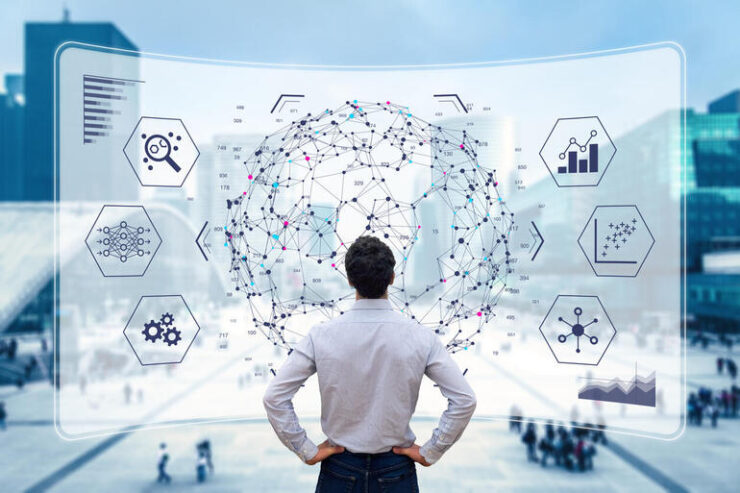Technology is a real game changer in the modern workplace. Most organizations now invest in automated systems fuelled by artificial intelligence to gain high-value real time data that drives better task performance. The presence of automated data engineering is larger than ever, and it has long-term benefits in the amplification of all human activities at business corporations.
There is no doubt that artificial intelligence and machine learning have eroded all industry domains and play a key role in operational processes. It is hence not surprising that artificial intelligence applications could contribute up to $15.7 trillion to the global economy by 2030.
Automated mechanized platforms are now making key decisions instead of humans at manufacturing houses, industrial settings, and specialized areas such as financial and healthcare institutions.
Workplace automation is the smartest way to enhance productivity and job efficiency. While the common buzz remains that artificial intelligence is a major cause in reducing workers that is far from the truth. Virtual assistants, Internet of Things (IoT)and chatbots have transformed how organizations go about mundane repetitive tasks and facilitate seamless team collaboration through complete data visibility.
It is high time for companies to utilize novel automated platforms to raise the bar and boost bottom-line results in key vital areas of performance. Employee performance management systems are radical tools that can be used to improve work engagement and improve aligned goal attainment.
Here are some innovative ways through which automated solutions that use artificial intelligence can augment employee performance:
Streamline Internal Communications and Query Resolution
Smooth communication practices amongst managers, employee, clients, and organizational stakeholders is essential at any workplace.
Artificial intelligence tools such as virtual phone systems help in automating repetitive responses and divert calls to available phone lines so that customers do not wait endlessly in long telephonic queues.
Instant information sharing and real-time data dashboards give service representatives the latest customer analytics so that they can provide callers an excellent support experience. Programmed chatbots bridge the gap between machines and humans by providing 24/7 accessibility and instant responses to customers, thereby increasing customer satisfaction levels exponentially.
Improve Worker Ergonomics
An unhealthy or hazardous workplace is sure to have a damaging reputation and demoralize the entire workforce. Artificial intelligence fuelled devices such as radio-frequency identification badges or sensors can help workers enhance workplace safety and boost up output levels. AI algorithms can find out the best working postures for intensive physical activities such as bricklaying or mining, and also formulate training tools for novice workers to improve ergonomics. This is highly useful for manufacturing industries with a high worker population deployed on field jobs as it saves time, money and effort in the long run.
Provides Quick, Agile and Continuous Feedback
Traditional annual performance reviews are an outdated concept that holds no value, rather managers today are in search of proactive feedback solutions to leverage employee potential.
Automated employee performance management systems are now popularly used as they facilitate mutual goal-setting, track progress milestones and give timely feedback to workers through multiple channels. Back-end machine learning devices curate tailor-made training programs that cater to specific worker needs and competencies along with providing a more meaningful experience.
One of the best parts about AI driven technology is that it is completely fair, and capable of eliminating any bias that threatens the accuracy of performance reviews. Automated performance management software indeed is a holistic solution that can identify, correct and build employee performance through better goal alignment and communication.
Escalate the Quality of Talent Management
Grabbing the right talent is one of the biggest challenges for modern-day organizations in the fast-paced business ecosystem.
HR technology is at an all-time high and recruiters all over the globe use AI fuelled hiring tools to get the perfect match for vacant job openings. Predictive analytics of automated performance systems can identify skill gaps and aid in the development of comprehensive training modules along with well-rounded employee learning programs. Any business software that helps to manage employee information and HR related tasks can be considered HR software.
It is also likely that artificial intelligence applications will reduce the need for jobs with repetitive and time-consuming actions, thereby increasing the urgent requirement for skill-intensive technical labour in all fields.
At the end of the day, human resource managers will find that artificial intelligence and machine learning platforms improve talent acquisition, on boarding and performance management, thus streamlining HR practices for higher job engagement.
Robust Data Analytics for Problem Solving
Prior to the advent of artificial intelligence and automated technology, businesses had to rely on manual data entry which would often lead to slower response rates and inaccurate decisions.
However, employees are now armed with tons of sophisticated solutions such as automated CRM tools, opinion data mining, and social computing that can help organizations serve their clients in a more personalized manner. Neural networking models actually attempt to mimic human intelligence and propagate deep-rooted learning at multiple layers for accurate strategizing.
Data-based models and live simulations give employees a clear picture of client expectations and can be used for precise decision making. Machines and robots are far better than humans at handling multiple input factors for problem-solving and can give valuable insights that can lead to higher business revenues.
Artificial intelligence can process chunks of information at a scale and scope that is far beyond human capability. Knowledge engineering and intelligence retrieval tools can help HR managers develop an intuitive structured system to capitalize on maximum employee potential.
Conclusion
Smart technologies are changing our lives dramatically by edging their way into our homes and offices alike. AI has led to a disruption in the business arena and there is a huge debate raging about how the rise of machines and robots will displace human beings in the long run.
Well, that being said, it is high time to discard that argument as automated technologies are the future and need to be effectively embraced to complement human intelligence. The benefits of automated workplace technology are clear – cost-effectiveness, augmented data analytics, and talent recognition in organizations that will surely boost all vital performance metrics.




























